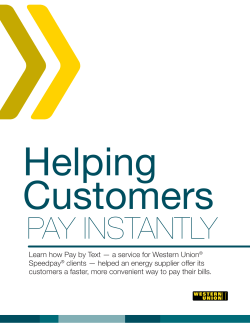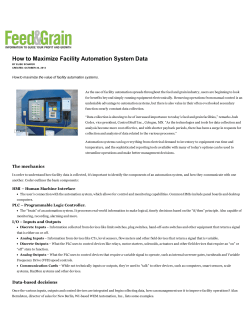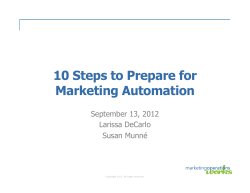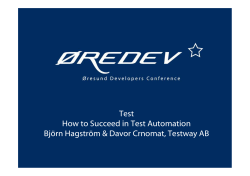
How To Build A Bullet-Proof Justification For Your New IVR
How To Build A Bullet-Proof Justification For Your New IVR Using insights from your callers' actual experiences instead of unreliable "guesstimates" from vendors and consultants gives you a business case that you can trust. The opportunity to reduce costs using IVR automation is widely proven - with many case studies citing 10-30% or greater reductions in agent-handled calls. Yet many companies struggle with the decision to invest in new or upgraded IVR systems. Obstacles to gaining management support and budget approval can include: • Problems and opportunities in current call handling are not visible in existing reporting. • Caller dis-satisfaction with IVRs raises questions for any proposal to subject more callers to IVR automation. • Cost savings based on vendors' and consultants' projections are perceived to be untrustworthy. • Too many stories or past experiences with IVR projects that did not meet expectations. These barriers share one common trait - they can all be traced to incomplete information and its consequences. For example, with no simple way to quantify actual caller behavior, companies too often rely on vendors' optimistic projections to justify new investments. Companies also readily acknowledge gaps in reporting, which can give the false impression that the current IVR is working satisfactorily. And lacking visibility of actual caller interactions to guide design choices, voice developers continue to use the same "best practices" that have produced the current generation of frustrating voice user interfaces. Fortunately for both callers and call centers, innovative new solutions have finally made it cost effective and practical to gain insight into actual callers' behavior and experience. New technology has solved one problem - following the caller from dialing to hang-up (across all transfers & without installing any new software!). And, it has begun to address another - replacing manual categorization of calls with automated analyses. With a true cradle-to-grave view of how and where callers spend time, companies can now replace subjective "guesstimates" with solid data about where their callers get frustrated and where their agents' time is wasted. The result is a compelling and concrete business case for new IVR automation and reduced risk of failing to meet expectations. Limitations Of Traditional Approaches The analysis of the potential value of a new or upgraded IVR has traditionally started with an examination of existing data. Such data may include call detail records, switch reports, IVR logs, and reports from agent desktop applications. Desktop application reports may include agent-provided information about the call. Unfortunately though, such data can be problematic. It's not atypical to find ~20% of calls marked "resolved" by agents (who sincerely believe they did their job), while the caller is unsatisfied and considers their inquiry unresolved. And pressures to minimize handle time can drive agents to quickly complete a form rather than thoughtfully select the best classification for each call. Before analysis can begin, existing data must first be extracted from a myriad of voice and data systems. This seemingly simple step can easily take weeks or months. Some data may be impossible to access, such as that held in systems belonging to suppliers and outsource partners. Next, available data needs to be cleansed and prepared for analysis. Some methodologies include the transformation of all data sources into a common form. At a minimum, data from disparate systems must be aligned so that calls in one system can be linked with data about the same calls in another. Finally, analysis can begin. Findings typically describe conditions at a specific site or step in the call flow: • • • • Breakdown of transaction types (using desktop data or agent classification) Transfer rates and destinations by site or skill Top locations where callers opt-out or hang-up Self-service task success & failure rates Such findings describe what happened - but can't describe why it happened. This is a very significant deficiency, since understanding why callers or agents take certain actions is required to design strategies that will change their behavior. Understanding why requires an assessment of intent and emotional state as callers proceed through interactions with automation and/or agents. Unfortunately, this level and quality of understanding simply can't be extracted from data such as application logs and call detail records. Notwithstanding problems in the underlying data sources and the time and effort required to get this far, such findings can be helpful if used properly. Typically though, the next step requires companies to take a leap of faith. It's not uncommon to find the following kinds of assertions after charts and graphs of existing data: • If we move 20% of transaction A into self-service, we will reduce agent-handled call volume by x%. • If we increase self-serve rates by 10%, we will save $x millions of dollars per year. • If we reduce transfer rates by 15%, we will save $xxx thousands of dollars per year The trick seems to be to propose a target that isn't too aggressive, but is large enough so that the savings potential gets attention. Usually a few sample actions are described, such as building a new application, implementing speech or re-recording prompts. But rather than a roadmap of actions that will each produce a specific portion of the hoped-for benefit, there is instead an assumption that following "best practices" will yield the intended results. To senior managers evaluating budget priorities, many questions remain unanswered: • • • • Why are callers opting-out, failing or hanging-up? Why are callers being transferred? Why are call volumes or handle times increasing? What evidence is there that _____________ (e.g. re-recording prompts, new self-service, natural language routing, etc.) will make a measurable difference in our call centers and with our callers? • How do our agents handle calls that fail out of the IVR? • How many callers will use each proposed self-service application and how much agent time will each save? • What exactly are the top 3 things that will produce the expected savings or satisfaction improvements? At this point, there are two possible outcomes - neither of them satisfactory. The proposed IVR project may fail to get management support. This is very disappointing for the line-of-business, the IVR team and the call center, who are usually correct in their belief that a well designed IVR would indeed reduce costs and improve caller satisfaction. Or, the company may proceed with the project (with unduly optimistic expectations). Unfortunately, given the limited understanding of actual caller experience and reasons for caller behavior, there is significant risk that the resulting system will fail to meet its goals. In summary, the traditional approach to evaluating the potential value of a new or upgraded IVR can be described as follows: IVR Strategy From Existing Data 1. 2. 3. 4. 5. Extract and transform existing data Identify problems and/or opportunities (i.e. what is happening) Pick an improvement target that seems both achievable and compelling Implement the new IVR using the chosen developer's "best practices" Iterate and tune until project goals are achieved or resources are exhausted There are two notable weaknesses in this approach. First, there is relatively little quantitative analysis behind the project goals for reduction in costs or improvement in caller satisfaction. And second, the new system is designed using "best practices" rather than a true understanding of the center's unique caller population. Unfortunately, evidence of these shortcomings is plentiful. According to a Frost & Sullivan 2006 IVR report, the primary reason for reluctance to deploy speech self-service is its failure in the past. And, a Yankee Group consumer study in 2007 reported that 2/3 of respondents say they regularly opt-out of automated systems. An IVR Strategy Based On Knowing Your Caller Freed from the constraints and limitations of existing data, leading edge call centers are using caller experience analysis to drive IVR automation strategy. Rather than speculate on incremental improvements and hope that "best practices" will achieve them, companies can now measure actual caller behavior and quantitatively model the impact of new or upgraded IVR automation. This new approach to planning IVR automation and quantifying expected benefits follows 5 steps: IVR Strategy Using AVOKE Methodology 1. Capture dialing to hang-up caller experience (any and all IVRs, queues and agents, in-house & outsourced) 2. Identify problems and/or opportunities (what is happening) 3. Determine root cause of caller and agent behavior (why it's happening) 4. Formulate and quantify strategies for new/improved IVR automation 5. Implement the new IVR using knowledge of caller behavior and identified automation strategies Problems and opportunities are found by analysis of how callers spend time from the moment they dial the contact number until the moment they hang-up. As the 2007 Yankee Group study confirmed, the top sources of caller dissatisfaction are all related to wasting the caller's time. Of course, unnecessary time in the call also drives excess cost. Percentage of Respondents Reason Long hold times 63% Confusing automated menus 50% Too long to answer 27% Too many rep transfers 21% System or agent did not have previously entered info 19% Agent lack of knowledge about you 12% Other 8% Top Sources Of Customer Dissatisfaction Yankee Group, Anywhere Consumer 2007 US Survey By optimizing how time is spent in the call, call centers can simultaneously achieve both greater efficiency and improved caller satisfaction. The analysis of how callers spend time uncovers 3 specific types of opportunities. Eliminate The Need For The Call The best way to save call time is to eliminate the call entirely. And, the first calls to eliminate are those repeat calls that are triggered by failure of an earlier call. Analyzing how the first call ends reveals those that were not served at all, and those that were served unsatisfactorily (by either agents or IVR automation). These callers will call again, and the first call needlessly wasted both caller and call center time. More calls can be eliminated by analyzing the true reason for the call. This reveals calls that can be avoided by proactive notification and by improvements in other contact channels. Reduce Total Caller Time Managing queue times is well-understood, so the next focus is to find opportunities to reduce IVR time and/or agent time. For example, many IVRs are unnecessarily verbose, which extends IVR time, causes opt-outs, and drives excess cost in telecom charges and IVR resources. Opt-outs and other IVR misroutes can also waste the first agent's time, whose only contribution may be to transfer the caller to the correct agent. Comparing interactions for the same activity in the IVR versus with agents can also reveal more efficient IVR dialog structures. Error-handling in the IVR can also be a very large time sink, sometimes with only marginal recovery benefit. Finally, opportunities can be found to optimize the process environment that agents operate within - such as needlessly repeating tasks completed previously in the IVR. Shift Time From Agents To Automation This is the primary focus of most IVR automation initiatives. Analyzing how callers spend time with agents reveals those repetitive activities that are a good fit for IVR automation. The list of automatable activities can be further classified into those that are the best fit for various input modalities, such as touch-tone, directed dialog and/or natural language. For each discovered IVR automation opportunity, the cradle-to-grave view of the call enables measurement of the amount of time currently spent by callers and agents. For example, one can measure the amount of time that agents and callers spend on an automatable identification task, the amount of time wasted by opt-outs or misroutes at a specific menu location, or the amount of time wasted by an unnecessary call. Multiplying this time measurement by the frequency of occurrence of each opportunity yields the maximum possible improvement potential. Of course, this upper limit can never be achieved, since callers are never 100% cooperative or 100% successful with IVR automation. Instead, the upper limit serves as a useful boundary for testing expectations. Caller-Centric Design Having identified, quantified, and prioritized the highest value automation opportunities; the next step is to establish design strategies for each that will maximize caller success. These design strategies provide a crucial link between the planning and implementation phases. Design strategies serve as a knowledge transfer vehicle. They encapsulate knowledge of "why" callers in a specific center behave as they do such that it can be applied to voice user interface design. Without this knowledge transfer, IVR designers are denied the opportunity to tailor the user interface to the unique needs and behaviors of callers to a specific center. Without such understanding, "best practices" can produce an acceptable design for the "average" caller. But, interaction design based on an understanding of how and why a specific caller population behaves produces a higher performance result. Quantifying Expected Results To quantify the value of each identified IVR automation opportunity, the impact of each corresponding design strategy can be modeled. Such analysis may find, for example, that an identification module in the IVR would replace 60 seconds of agent time with 70 seconds of IVR time. This change can be modeled for the center's total volume by multiplying it by the percentage of callers that will likely use the new identification module successfully. Essentially, this caller-centric methodology employs a time study of the paths callers take, the call process, and the interaction steps from dialing to hang-up. Time usage is evaluated for each different reason for call, since each different reason has its own intended caller path - and its own actual map of how many callers follow that path and how many opt-out, abandon, misroute or otherwise fail. The key is to analyze the behavior of all callers with the very same need - and to understand why some succeed and others fail. The result is a quantified roadmap for IVR automation, based on a deep understanding of the center's callers and business objectives. The roadmap consists of 3 major components: IVR Automation Roadmap 1. List of each significant IVR automation opportunity and it's magnitude in terms of total caller and agent time. 2. Specific design and implementation strategies for each IVR automation opportunity. 3. Expected value of each implementation in terms of caller utilization and saved caller and agent time. Despite the obvious value of a data-driven strategy and informed IVR investment decisions, such comprehensive analysis of caller behavior and IVR automation potential has historically been impractical. It was too difficult to assemble a cradle-to-grave view of the call. The analysis work is labor intensive and required specialized expertise. And, business timelines and priorities did not allow for 612 month investigations. A New Breed Of Analytics BBN developed AVOKE Analytics to simply and quickly deliver data and insights about a center's actual caller experiences to operational management and strategic decision making. BBN's solution consists of the AVOKE Call Browser and the AVOKE Methodology. The methodology provides a repeatable framework for synthesizing quantified action plans from caller experience data. And, the AVOKE Call Browser is a revolutionary new software-as-a-service that captures and analyzes caller experiences. Key attributes of the AVOKE Call Browser system include: True End-to-End View The AVOKE Call Browser captures the entire call from the moment the caller dials the contact number until the caller hangs-up, including all transfers and all outsource partner resources. Data, Audio and Transcription The AVOKE Call Browser combines call data, cradle-to-grave audio recordings, and a full text transcription in a single interactive environment. Search and data views enable discovery of patterns (what happened), with drill-down to actual call audio to understand caller intent and emotion (why it happened). Path Data and Audio in the IVR Listening to callers navigate, succeed, and fail in the IVR - and then following them to the agent - is the only way to truly understand caller behavior. Audio in Queue Listening to callers in queue provides another opportunity to learn more about the caller's intent, emotional state, and view of the IVR and/or agent. Audio with Agent Find and quantify automatable tasks. Learn how agents succeed at tasks the IVR failed to complete. Quick Results Budget cycles allow a few months to evaluate and build business cases for new initiatives. The AVOKE Call Browser is typically up and running within 2 weeks. No Software Purchase Your goal is to evaluate the business case for IVR automation. You don't need to buy a complex software package that you'll only use for a couple months. No IT Integration Using patented BBN technology, the AVOKE Call Browser is integrated in the phone network, not in your data center. About AVOKE Analytics AVOKE Analytics is a cloud-based whole call recording and analytics solution. The solution enables companies to optimize service performance from the customer’s perspective. The AVOKE system records calls in the telecom network, eliminating IT requirements and obstacles. It follows your customers, uninterrupted, through their entire journey as they traverse the IVR, all transfers, internal call centers and partner sites. The solution consists of the AVOKE Call Browser system, the AVOKE Customer Effort Index benchmark service, and AVOKE Professional Services. For more information on AVOKE Analytics, contact: Raytheon BBN Technologies 10 Moulton Street Cambridge, MA 02138 avoke@bbn.com 617-873-1600 www.avoke.com
© Copyright 2025











